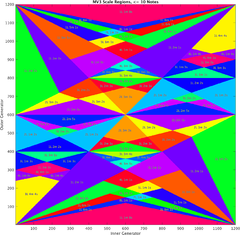Generator-offset property: Difference between revisions
→Open conjectures: moving this and the following section to 3ary scale theorems, rewriting this article |
|||
| (3 intermediate revisions by the same user not shown) | |||
| Line 11: | Line 11: | ||
Generator-offset scales generalize the notion of [[dipentatonic scale|dipentatonic]] and [[diheptatonic scale|diheptatonic]] scales where the pentatonic and heptatonic are [[MOS scales]]. A related but distinct notion is [[alternating generator sequence]]. While scales produced using the generator-offset procedure can be seen as a result of an alternating generator sequence of 2 alternants, the generator-offset perspective views the sum of the two alternants as the "canonical" generator, and the alternants as rather being possible choices of the offset which are effectively equivalent up to chirality. While a well-formed AGS scale requires each alternant in the AGS to subtend the same number of steps, the generator-offset property only requires each (aggregate) generator to subtend the same number of steps. | Generator-offset scales generalize the notion of [[dipentatonic scale|dipentatonic]] and [[diheptatonic scale|diheptatonic]] scales where the pentatonic and heptatonic are [[MOS scales]]. A related but distinct notion is [[alternating generator sequence]]. While scales produced using the generator-offset procedure can be seen as a result of an alternating generator sequence of 2 alternants, the generator-offset perspective views the sum of the two alternants as the "canonical" generator, and the alternants as rather being possible choices of the offset which are effectively equivalent up to chirality. While a well-formed AGS scale requires each alternant in the AGS to subtend the same number of steps, the generator-offset property only requires each (aggregate) generator to subtend the same number of steps. | ||
Note: In Inthar's contribution to [[aberrismic theory]], this term has been superseded by [[guide frame]]s. | |||
== Mathematical definition == | == Mathematical definition == | ||
More formally, a cyclic word ''S'' (representing the steps of a [[periodic scale]]) of size ''n'' is '''generator-offset''' if it satisfies the following properties: | More formally, a cyclic word ''S'' (representing the steps of a [[periodic scale]]) of size ''n'' is '''generator-offset''' if it satisfies the following properties: | ||
| Line 16: | Line 17: | ||
# The scale is ''well-formed'' with respect to g, i.e. all occurrences of the generator g are ''k''-steps for a fixed ''k''. | # The scale is ''well-formed'' with respect to g, i.e. all occurrences of the generator g are ''k''-steps for a fixed ''k''. | ||
[[Category:Scale]] | [[Category:Scale]] | ||
Latest revision as of 13:19, 9 August 2024
A scale satisfies the generator-offset property if it satisfies the following properties:
- The scale is generated by two chains of stacked copies of an interval called the generator.
- The two chains are separated by a different interval called the offset (the difference between the first note of the second chain and the first note of the first chain).
- The lengths of the chains differ by at most one. (1-3 can be restated as: The scale can be built by stacking two alternating generators (called alternants) a1 and a2. Note that a1 does not need to subtend, i.e. occur as, the same number of steps as a2.)
- The generator always occurs as the same number of steps. For example, the generator is never both a 2-step and a 3-step.

The Zarlino (3L 2M 2S) JI scale is an example of a generator-offset scale, because it is built by stacking alternating 5/4 and 6/5 generators. The 7-limit version of diasem (5L 2M 2S) is another example, with generators 7/6 and 8/7.
Generator-offset scales generalize the notion of dipentatonic and diheptatonic scales where the pentatonic and heptatonic are MOS scales. A related but distinct notion is alternating generator sequence. While scales produced using the generator-offset procedure can be seen as a result of an alternating generator sequence of 2 alternants, the generator-offset perspective views the sum of the two alternants as the "canonical" generator, and the alternants as rather being possible choices of the offset which are effectively equivalent up to chirality. While a well-formed AGS scale requires each alternant in the AGS to subtend the same number of steps, the generator-offset property only requires each (aggregate) generator to subtend the same number of steps.
Note: In Inthar's contribution to aberrismic theory, this term has been superseded by guide frames.
Mathematical definition
More formally, a cyclic word S (representing the steps of a periodic scale) of size n is generator-offset if it satisfies the following properties:
- S is generated by two chains of stacked generators g separated by a fixed offset δ; either both chains are of size n/2 (implying n is even), or one chain has size (n + 1)/2 and the second has size (n − 1)/2 (implying n is odd).
- The scale is well-formed with respect to g, i.e. all occurrences of the generator g are k-steps for a fixed k.